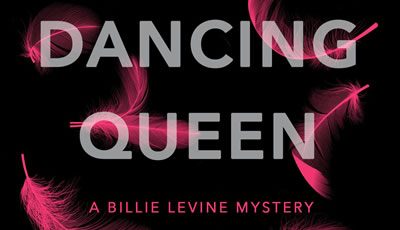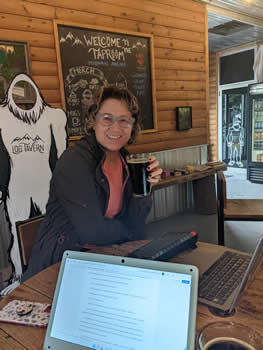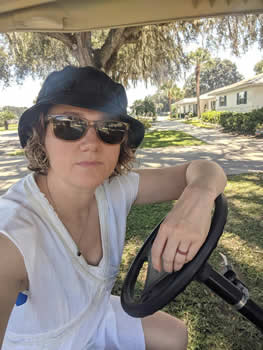

Features Up Close: Kimberly G. Giarratano
With Billie Levine, a Feisty New Female PI Enters the Crime Lit Scene
 By Dawn Ius
By Dawn Ius
The past and present of organized crime are connected in Kim Giarratano’s debut adult novel, DEATH OF A DANCING QUEEN, a twisty, hard-boiled mystery that will have you simultaneously clutching the side of your chair in fear and your stomach in laughter.
Twenty-four-year-old Billie Levine needs a job—something that will help her earn enough money to care for her mother, who has just been diagnosed with Alzheimer’s. Her best option is to revamp her grandfather’s PI firm, and she quickly gets her first case—a rich kid with a drug habit and a wad of cash hires her to find his missing girlfriend. Easy peasy. Or so Billie thinks. Before she knows it, Billie finds herself caught up in a decades-old gang war with ties to a Jewish mob, a missing cabaret dancer, and a skinhead group.
Suddenly, Billie isn’t so sure this PI business is the answer to her problems.
Here, Giarratano spends time with The Big Thrill to talk about balancing humor with crime, writing for the adult market, creating an #ownvoices character that appears to be resonating with the masses, and of course, the awesomeness of free pickles.
I’m always so interested in how ideas form for writers, but in this case, I’d love to know not only what sparked the idea for DEATH OF A DANCING QUEEN, but also its perfect title. Did the title come first, or as a result of the story you were writing?
I’m going to start with your second question, although I feel like this will disappoint you a little. DEATH OF A DANCING QUEEN was not the original title, nor was it a title that I thought would stick. It was honestly a throwaway title—something I came up with on the fly when my agent asked me to retitle the manuscript while we were pitching it (the book was originally called The Malta Club). I figured, “Eh. An editor will probably want to change it anyway.” And my editor did; she preferred my original title. But the distribution and marketing teams loved DEATH OF A DANCING QUEEN, thus we kept it. The lesson here: authors are not the best marketers. The feedback has been: “What a great title!” And I’m like, “Thanks!” But honestly, I was off my game. So let’s just call this a happy accident.
As for what sparked DEATH, I was sorta bereft after finishing Season 4 of Veronica Mars on Hulu. I love hard-boiled fiction, and I’m a big fan of Raymond Chandler and Elmore Leonard. I also love Janet Evanovich’s Stephanie Plum, so I thought, “I’m funny. I’m good at grit. Let’s marry the two.” Also, it’s not like I can kidnap Rob Thomas and force him to write more VM episodes. Right? I can’t do that? No? Ok. Yeah, so I decided to write my own fun.
I fell immediately in love with your protagonist—a female Jewish PI. Can you recall a single moment when Billie Levine came into focus for you?
First of all, thank you. Second, I just dug out my notebook to see if I could answer this question, but of course Past Kim didn’t date anything so Future Kim could sound smart. Most of the time, my protagonists come to me fully fleshed out. I’ll envision them, and then ask some questions. In Billie’s case: What if she’s broke? And her mom has Alzheimer’s? And her ex is a criminal? And her college degree is worthless? And her grandpa is a curmudgeon? And then I’ll see how I can build a plot from that. The characterization feels really organic—the plotting, not so much.
Billie really seems to be resonating with early readers. Why do you think people are connecting with her? In your opinion, what is her most endearing trait? When you first created Billie, did you see an empty space in crime lit that you wanted to fill?

Who says you have to write in a coffee shop? Giarratano often drafts with a pint at Log Tavern Brewery in Milford, Pennsylvania.
I think Billie resonates with readers because she is vulnerable, sympathetic, self-deprecating, and hard-working. And those are all qualities we value in people. She’s also incredibly self-assured for 24 years old. I mean, she struggles, but she knows who she is. I didn’t know squat about myself at 24.
And, yeah, I did see a space in crime lit that I thought should be, not filled, but expanded. Janet Evanovich’s Stephanie Plum, Sara Paretsky’s V.I. Warshawski, and Sue Grafton’s Kinsey Millhone are so freaking iconic, but I was wondering where I could find the new generation of female private eyes. I got into Kristen Lepionka’s Roxane Weary series, Tracy Clark’s Cass Raines series, and Rachel Howzell Hall’s Lou Norton books, but I felt greedy; I wanted more. Unlike standalone thrillers or cozy sleuths where there are an abundance of riches, I was struggling to find other female-led PI novels that were gritty, wry, and new.
That said, DEATH had gotten rejected at an acquisitions meeting (at a decent-size publisher) because there were no recent comp titles of well-selling, female-led PI fiction to satisfy the numbers people. Apparently Janet Evanovich and Sue Grafton didn’t count. I’m hoping things are changing. Alex Kenna just released What Meets the Eye from Crooked Lane Books about a female PI in Los Angeles, and my friend Delia Pitts has a forthcoming novel from Minotaur Books about a Black female PI in New Jersey. I’ve joked that Delia and I should go on a book tour called, “Garden State Gumshoes.” We might do that if I can convince her.

During a trip to her parent’s Florida community, Giarratano drives a golf cart for the first time, feeling very badass.
Billie is up against a lot in her new PI role—and there’s a lot going on in her life too, between her mother’s Alzheimer’s diagnosis, taking over her grandfather’s old PI firm, not to mention the shady characters she deals with when she goes up against the Jewish mob and a skinhead group. I imagine you had to do a bit of research to make this all come together. What was the most surprising thing you learned?
Despite loving someone with dementia, I really had to research early-onset Alzheimer’s disease because my family member’s illness presents differently than Billie’s mom. However, Billie’s fears about her own health stem from a very personal place. What is so surprising about medical research in general is that it is always changing. Coffee is great to ward off Alzheimer’s! Drink five cups a day. Uh, wait, maybe not. Puzzles help the brain! Eh, only a little, or maybe not at all. Also early-onset is a different ballgame from late on-set. For everything that depressed me, I made up for it with some funny quips later on in the book.
Okay, given my love of pickles, *I* would probably set up shop next to a place that gave them away free, too. Is this wish fulfillment or is this magical pickle dispensary based on a real (obviously awesome) deli? (Also, do you need to buy anything else to get a pickle?)
I’m not gonna lie; part of it is wish fulfillment. However, if you’re in Manhattan, go to Sarge’s Delicatessen in Murray Hill. Their coleslaw is off the hook, and they throw in half-sours with your order. Anyone (ahem, my spouse) who says Jewish food isn’t on par with other well-loved cuisines hasn’t been to a good deli. Or eaten my grandmother’s brisket.
While DEATH OF A DANCING QUEEN is your first adult novel, you’ve had some success in the young adult market. What was the catalyst for embarking on a new path? What was the biggest challenge in pivoting your writing from YA to adult?
The catalyst for writing adult fiction was this idea for a PI series that I could not envision with a teen protagonist. Also, I really thought I would stay an indie author, and since most teens don’t read e-books, I figured I’d have more success writing a series for adults. That said, and I’m not sure if this is irony because I am bad at identifying it, but I think DEATH is a great crossover read for teens. And I’m not just saying that because Library Journal also said that.
I don’t feel like it was that much of a leap to create an adult protagonist. For one thing, I am an adult. I definitely remember being a broke 24-year-old, so it wasn’t too hard to dig into that part of my life. It sounds so simple, even though I know it wasn’t, but I created this woman who was going through the challenges of adulthood. She has bills to pay and lives to save, but also she lives at home with her grandfather who treats her like a kid and a mom she has to parent. She’s in a real in-between; I just had to constantly remember that.
With a title like DEATH OF A DANCING QUEEN, it makes sense that you might have curated a playlist while writing this. Were there any particular songs that were knocking around in your head while during the drafting stage?
(Opening Spotify) I know ABBA is the obvious choice here, but I am an alternative rock chick (with some Latin dance thrown in), so the playlist is going to read like ’90s revival. Definitely U2’s “All I Want Is You,” Fiona Apple’s “Criminal,” and Foo Fighters’ “Best of You.”
Readers will be thrilled to know that DEATH OF A DANCING QUEEN is the first book in a new series. What can you share about the second installment?
I’ll share my groovy title that I came up with, and I hope this one sticks because I am marveling at my own cleverness. Actually, I sorta stole it from a song title, but it’s called, Devil in Profile. In this book, Billie’s boyfriend is being framed for the murder of an elderly art collector who has ties to Nazi Germany. It’s a beast to plot, but it’s going to be awesome.
- On the Cover: Alisa Lynn Valdés - March 31, 2023
- On the Cover: Melissa Cassera - March 31, 2023
- Behind the Scenes: From Book to Netflix - March 31, 2023


